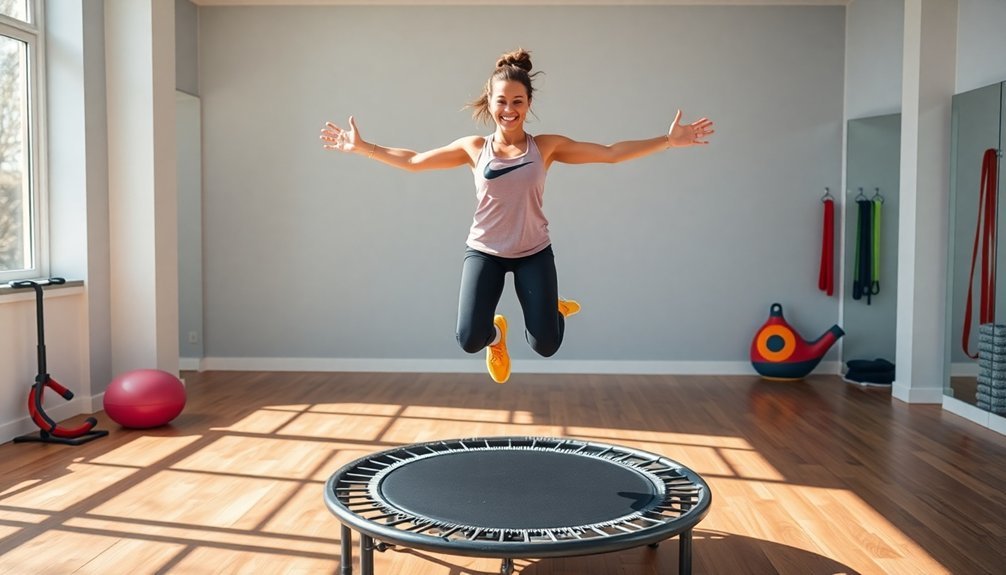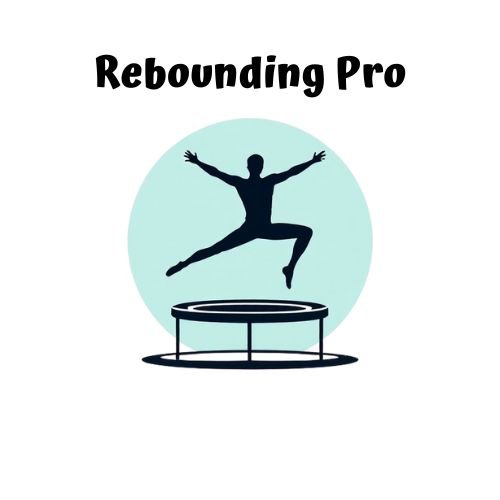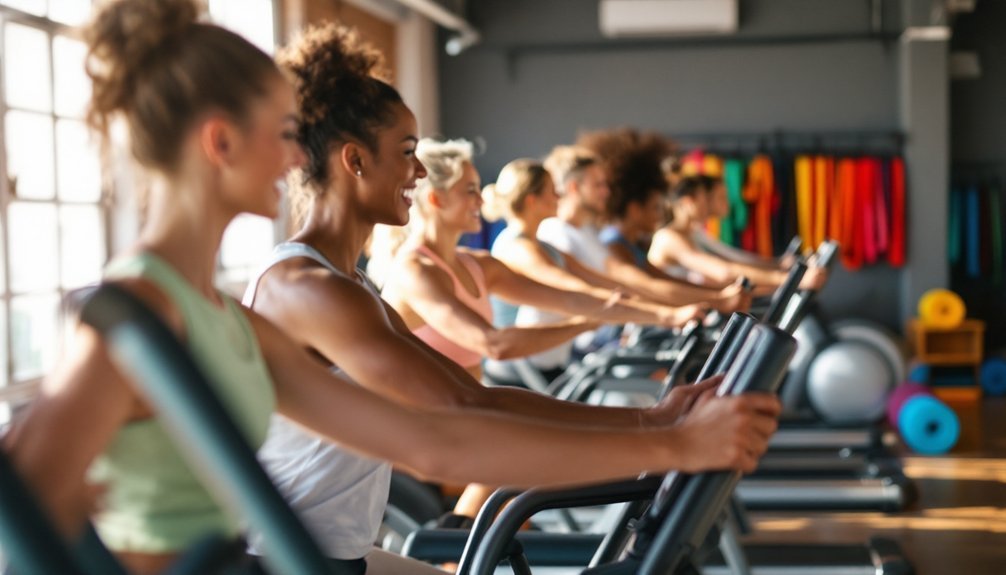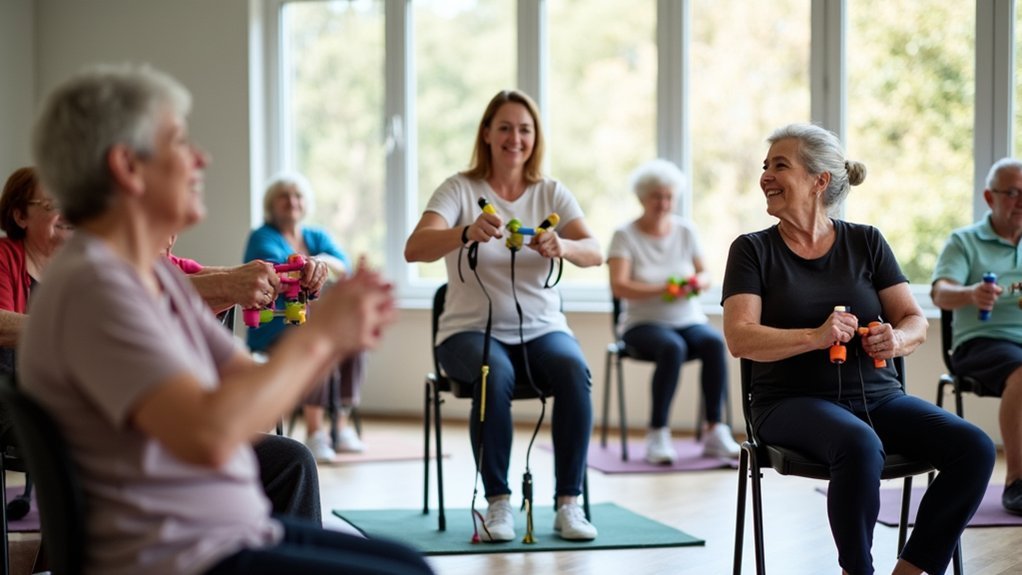Looking for high-intensity workouts without the joint strain? Try rebounding (mini-trampoline exercises), which NASA found delivers 30 minutes of running benefits in just 10 minutes. Other effective low-impact options include swimming, rowing, elliptical training, cycling, water aerobics, and modified HIIT routines. These workouts elevate your heart rate and burn calories while protecting your joints. Discover how these seven options can transform your fitness routine while keeping your body safe.
The Science Behind Rebounding: Why It's Gentle Yet Effective

While many people associate effective cardio with high-impact activities like running or jumping, rebounding offers a revolutionary alternative that's scientifically proven to deliver remarkable results. NASA research found that 10 minutes on a rebounder equals 30 minutes of running, but with minimal joint strain.
When you bounce, your body experiences a unique gravitational stimulus that strengthens both muscles and bones simultaneously. This action triggers stronger biological responses than traditional cardio, enhancing your endurance more efficiently. NASA initially studied rebounding to help astronauts maintain bone density during space missions.
What makes rebounding truly special is how it stimulates your lymphatic system, boosting immune function and detoxification. Your body experiences the intensity needed for cardiovascular improvement without the harmful impact on your joints—making it accessible regardless of your fitness level or age.
Getting Started With Rebounding: Equipment and Space Needs
Now that you understand the impressive benefits of rebounding, let's focus on what you'll need to start bouncing your way to better health.
Choose between bungee rebounders, which offer quieter, controlled bounces ideal for beginners, or metal spring models for firmer, higher-intensity workouts.
Consider your weight capacity needs (most support up to 150kg) and whether you'd benefit from additional features like handlebars for balance or resistance bands.
Ensure your rebounder matches your weight requirements and consider stability aids for a safer, more versatile workout experience.
You'll need about 3-4 feet of diameter space plus clearance around it for safe movement.
Many rebounders fold away for easy storage when not in use, making them practical for home workouts.
Budget options like Costway provide affordability with essential features, while premium models like Fit Bounce Pro II offer enhanced durability and performance.
When shopping for a rebounder, always verify the product has proper test certificates from recognized authorities in the UK, EU, or USA to ensure safety standards are met.
20-Minute Rebounding HIIT Workout for Maximum Calorie Burn

Just 15 minutes on a rebounder can transform your fitness routine with high-intensity interval training that maximizes calorie burn while protecting your joints.
NASA research shows rebounding is up to 68% more effective than jogging for calorie expenditure on quality equipment. Your workout will alternate intense 20-60 second intervals with brief 10-30 second recovery periods to create that coveted EPOC effect, burning calories long after you've finished.
- Incorporate squat walks to target leg muscles while maintaining low impact
- Add bunny walks to engage glutes and core simultaneously
- Try "Living Room Legs" for effective thigh and glute activation
- Include short jumping intervals to rapidly elevate your heart rate
- Use active recovery periods to maintain workout intensity and efficiency
For beginners or those with balance concerns, specific workouts designed with stability bars are available to ensure safety while still getting an effective workout.
Rebounding for Joint Health: Protective Benefits While Burning Fat
Unlike traditional high-impact cardio exercises that can ravage your joints over time, rebounding offers a revolutionary solution that protects your body while effectively burning fat.
This NASA-backed exercise creates a unique gravitational stimulus with each bounce, strengthening muscles and bones without stressing your joints.
You'll experience remarkable efficiency—just 10 minutes of rebounding equals 30 minutes of running in cardiovascular benefits.
If you suffer from arthritis, you'll find rebounding particularly beneficial, as it improves joint function more effectively than walking or cycling while reducing pain. With approximately 54 million adults in the U.S. having some form of arthritis, rebounding provides an accessible exercise option for many.
The bouncing motion also stimulates your lymphatic system, enhancing detoxification while you simultaneously strengthen your core, improve balance, and manage weight.
Always consult your doctor before starting, especially if you have existing joint conditions.
Advanced Rebounding Techniques to Elevate Your Heart Rate

While mastering basic rebounding techniques builds a solid foundation, advanced techniques can dramatically elevate your heart rate and maximize cardiovascular benefits.
HIIT rebounding workouts offer efficient 30-minute sessions that improve lung efficiency and oxygen intake, enhancing your VO2 max for better overall fitness and sporting performance. The unique low-impact aerobic nature of rebounding makes it an ideal choice for those seeking intense cardio without joint stress.
- Jump Squats build muscle strength and power while delivering intense cardio benefits
- Twist Jumps activate your core muscles while burning calories effectively
- High Knees improve coordination while driving your heart rate upward
- Single-Leg Hops challenge balance while strengthening your lower body
- Speed Skaters engage multiple muscle groups while demanding agility and balance
Always prioritize proper technique and use a high-quality rebounder to guarantee these advanced movements remain low-impact and joint-friendly.
Combining Rebounding With Resistance for Full-Body Conditioning
You'll maximize your rebounding workout by adding resistance bands for simultaneous cardio and strength training.
Create effective circuits that alternate between trampoline bounces and resistance moves to target multiple muscle groups while maintaining an elevated heart rate.
Your joints will thank you as you master proper bounce techniques that combine the low-impact benefits of rebounding with the muscle-building potential of resistance work. This approach is ideal for those seeking safer alternatives to high-impact activities like running, which can put excessive stress on your knees and other joints.
Trampoline Band Combinations
Combining rebounding with resistance bands creates one of the most efficient low-impact workout systems available today.
This dynamic duo engages multiple muscle groups while protecting your joints from the harsh impact of traditional cardio. You'll enjoy improved cardiovascular health and muscle strengthening simultaneously as you bounce and pull against resistance.
Whether you're a beginner or advanced athlete, trampoline band workouts can be tailored to your fitness level through HIIT formats or steady-state training. The equipment is cost-effective and requires minimal space, making it perfect for home workouts. Following Michelle Briehler's 55-minute workout format gives you a perfectly timed exercise routine that maximizes both cardio and strength benefits.
- Burns calories while being gentle on joints
- Improves coordination and balance through multi-planar movements
- Boosts metabolism through combined cardio and strength training
- Provides scalable resistance options for all fitness levels
- Enhances mood through endorphin release and enjoyable movement patterns
Rebound-Resistance Circuit Design
Creating effective rebound-resistance circuits transforms simple trampoline exercises into thorough full-body workouts.
By integrating resistance bands with rebounding, you'll engage multiple muscle groups while maintaining low joint impact.
Design your circuit with a variety of exercises—combine burpees on the rebounder with resistance band pull-aparts for simultaneous cardiovascular and strength benefits.
Incorporate HIIT protocols with strategic work-to-rest ratios to maximize calorie burn and efficiency.
For ideal results, focus on proper bouncing mechanics and breathing techniques.
Use adjustable resistance bands to modify intensity based on your fitness level.
Don't forget to include plyometric moves like jump squats to enhance power and explosiveness.
Always start with dynamic warm-ups and end with cooling stretches to prevent injuries and aid recovery.
Maintain uniform impedance throughout your movements to optimize energy transfer and prevent muscle fatigue during high-intensity rebounding sessions.
Joint-Friendly Bounce Techniques
Why are bounce techniques on a rebounder so beneficial for those with joint concerns? The elastic surface absorbs up to 87% of impact force compared to hard surfaces, protecting your knees, hips, and spine while still delivering an effective workout.
You'll improve cardiovascular fitness without the joint stress of running or jumping on firm ground.
- Start with gentle bounces, keeping your weight primarily through your heels
- Engage your core during movements like heel taps and side steps to enhance stability
- Incorporate breathing techniques—inhale during expansion, exhale during contraction
- Try toe-to-back steps to improve proprioception and balance
- Gradually integrate resistance bands to add strength training components while maintaining the low-impact nature
For absolute beginners, a five-minute workout can effectively build confidence in balance and core strength without requiring any jumping or bouncing.
Recovery and Progression: Building Your Rebounding Fitness Plan
After mastering basic rebounding movements, you'll need a structured approach to recovery and progression to maximize results while preventing burnout.
Begin with proper warm-ups and cool-downs to protect your joints and prevent injury.
Proper warm-ups and cool-downs aren't optional—they're your first defense against injuries and essential for joint protection.
Start at the beginner phase with short, high-intensity intervals and generous rest periods. As you advance, gradually increase workout duration and intensity while maintaining consistent rest intervals. Track your progress regularly to adjust your routine appropriately.
Don't skip rest days—they're essential for muscle recovery and preventing overtraining. Your rebounding fitness plan should prioritize low-impact alternatives that provide the same cardiovascular benefits without placing stress on your joints. Support your routine with adequate hydration, proper nutrition, and recovery techniques like stretching or foam rolling to reduce soreness.
For variety, incorporate different exercises such as squat jabs, modified burpees, and glute bridges to keep your rebounding workouts engaging and effective.
Frequently Asked Questions
Can Rebounding Help With Lymphatic Drainage and Immune System Function?
Yes, rebounding supports your lymphatic drainage and immune function. It stimulates one-way valves in your lymphatic system, enhances white blood cell count, and improves toxin removal while being gentle on your joints.
Is Rebounding Safe During Pregnancy or With Specific Medical Conditions?
Rebounding isn't recommended during pregnancy due to fall risks and abdominal pressure. You shouldn't rebound with high-risk pregnancies or conditions like placenta previa. Always consult your healthcare provider about your specific medical conditions before starting.
How Does Rebounding Compare to Swimming for Calorie Burn?
Swimming typically burns more calories than rebounding due to greater muscle engagement, but both are effective. Your intensity level matters—high-intensity rebounding can match moderate swimming for calorie burn. Choose what you'll enjoy consistently.
Can Rebounding Improve Balance and Coordination in Older Adults?
Yes, rebounding can greatly improve your balance and coordination as an older adult. It challenges your proprioceptive system, engages core muscles, and can enhance your stability by about 35% when practiced regularly.
Do Weighted Rebounding Vests Increase Workout Effectiveness or Injury Risk?
Weighted rebounding vests can increase your workout effectiveness by enhancing muscle engagement and caloric burn. However, they'll also raise injury risk if you don't maintain proper form or gradually introduce the extra weight.
In Summary
You've now discovered how rebounding delivers a powerful cardio workout while protecting your joints from impact. Whether you're a beginner or fitness enthusiast, this versatile exercise form adapts to your needs. As you incorporate these techniques into your routine, you'll experience improved cardiovascular health, stronger muscles, and better balance. Start small, progress gradually, and you'll soon reap the full benefits of this exceptional low-impact workout.





Leave a Reply